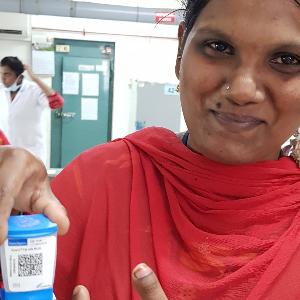
Laboratory technician Deepa from Christian Medical College (Vellore, India) presents the test cartridge examined in the study | © Dr. med. Laura Olbrich/Craig Dalgarno
- Some 240,000 children worldwide die of tuberculosis every year, because the disease is often misdiagnosed or not diagnosed in time.
- An international research consortium led by LMU has now tested a rapid new analytical tool with partners in South Africa, Malawi, Tanzania, Mozambique, and India.
- The tool, which needs just a small blood sample from the fingertip, has the potential to significantly improve the diagnosis of tuberculosis in children.
Munich, October 2023 - Around 240,000 children worldwide die of tuberculosis every year. The disease is among the top ten causes of death in children under the age of five. One of the main reasons for this mortality is that tuberculosis is often misdiagnosed or not diagnosed in time, particularly in regions with limited resources. A new diagnostic tool, which an international research consortium led by LMU medical scientists Laura Olbrich and Norbert Heinrich from the Division of Infectious Diseases and Tropical Medicine at LMU University Hospital Munich has tested as part of a large-scale study in five countries, offers significant progress in this area. The authors report on their findings in The Lancet Infectious Diseases.
Before now, the most commonly used tuberculosis tests have been based on microbiological analysis of sputum - that is, mucus taken from the lower airways. These samples are difficult to obtain in children. Moreover, child tuberculosis is often characterized by a low bacterial load and unspecific symptoms. "Therefore, new tests are urgently needed," says Olbrich.






